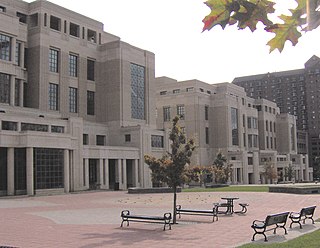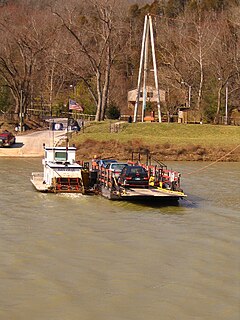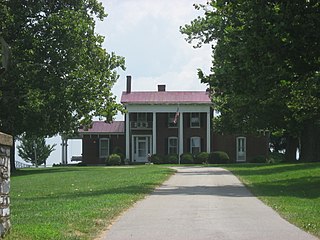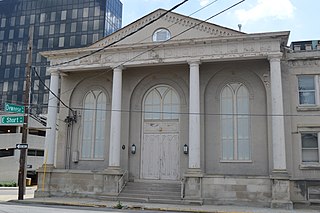
Jessamine County is a county located in the U.S. state of Kentucky. As of the 2020 census, the population was 52,991. Its county seat is Nicholasville. The county was founded in December 1798. Jessamine County is part of the Lexington-Fayette, KY Metropolitan Statistical Area. It is within the Inner Blue Grass region, long a center of farming and blooded stock raising, including thoroughbred horses. The legislature established a commercial wine industry here in the late 18th century.

Fayette County is located in the central part of the U.S. state of Kentucky. As of the 2020 census, the population was 322,570, making it the second-most populous county in the commonwealth. Its territory, population and government are coextensive with the city of Lexington, which also serves as the county seat. Fayette County is part of the Lexington–Fayette, KY Metropolitan Statistical Area.

Maysville is a home rule-class city in Mason County, Kentucky, United States and is the seat of Mason County. The population was 8,782 as of 2019, making it the 51st-largest city in Kentucky by population. Maysville is on the Ohio River, 66 miles (106 km) northeast of Lexington. It is the principal city of the Maysville Micropolitan Statistical Area, which includes Mason and Lewis counties. Two bridges cross the Ohio from Maysville to Aberdeen, Ohio: the Simon Kenton Memorial Bridge built in 1931 and the William H. Harsha Bridge built in 2001.
John Taylor (1752–1833) was a pioneer Baptist preacher, religious writer, frontier historian and planter in north and central Kentucky. His two histories of early Baptist churches in Kentucky provide insight into the frontier society of the early decades of the 19th century. His 1820 pamphlet entitled "Thoughts on Missions" put him at the center of the controversy within frontier Baptist congregations about supporting mission societies. In buying and selling land on the frontier, Taylor acquired 2,000 acres (8.1 km2) and 20 African-American slaves by the end of the first decade of the 19th century, thus entering the planter class.

Luke Pryor Blackburn was an American physician, philanthropist, and politician from Kentucky. He was elected the 28th governor of Kentucky, serving from 1879 to 1883. Until the election of Ernie Fletcher in 2003, Blackburn was the only physician to serve as governor of Kentucky.

Lexington Cemetery is a private, non-profit 170-acre (69 ha) rural cemetery and arboretum located at 833 W. Main Street, Lexington, Kentucky.

Richard Hawes Jr. was a United States representative from Kentucky and the second Confederate Governor of Kentucky. He was part of the politically influential Hawes family. His brother, uncle, and cousin also served as U.S. Representatives, and his grandson Harry B. Hawes was a member of the United States Senate. He was a slaveholder.

Edward Troye, was a Swiss-born American painter of Thoroughbred horses.

The Episcopal Burying Ground and Chapel is located at 251 East Third Street, in Lexington, Kentucky. The land was purchased in 1832 by Christ Church as a burial ground for its parishioners. The cemetery became extremely important during the 1833 cholera epidemic, during which one-third of the congregation died.

The Valley View Ferry provides passage over the Kentucky River in rural central Kentucky. Located on Kentucky Route 169, this ferry service connects auto traffic between the county seats of Richmond in Madison County and Nicholasville in Jessamine County. The ferry was founded in 1780, predating Kentucky's admission to the Union in 1792. It is widely regarded as the commonwealth's oldest continually operating business.

The third cholera pandemic (1846–1860) was the third major outbreak of cholera originating in India in the nineteenth century that reached far beyond its borders, which researchers at UCLA believe may have started as early as 1837 and lasted until 1863. In the Russian Empire, more than one million people died of cholera. In 1853–54, the epidemic in London claimed over 10,000 lives, and there were 23,000 deaths for all of Great Britain. This pandemic was considered to have the highest fatalities of the 19th-century epidemics.

The Washington Historic District in Washington, Kentucky was listed on the National Register of Historic Places in 1970, and its borders were increased in 1976. The buildings of Washington range from simple log cabins to late Georgian and early Federal styles constructed of home burned brick laid in Flemish Bond. Many houses have double doors at the entrance and a reeded roll length wise under a four light transom.

The Young House is an historic estate in Jessamine County, Kentucky, United States, in the city of Wilmore off of Kentucky Route 29 on Lexington Road. The reference to Nicholasville, Kentucky in the title of this page is incorrect. Popular legend has it that the house was the birthplace of Bennett H. Young, an American Civil War soldier, lawyer, and architect.

Christ Church Cathedral is the seat of the Episcopal Diocese of Lexington and is located at 166 Market Street, Lexington, Kentucky. Founded in 1796, Christ Church Cathedral is the oldest Episcopal church in the Commonwealth of Kentucky. Renovations over the years have sought to preserve the original structure, and it remains relatively unchanged. The church created what is now called the Old Episcopal Burying Ground, located nearby. It held many who died during the cholera epidemics of 1833 and 1848, but most of the remains have been moved due to flooding.

First African Baptist Church is a historic church at 264-272 E. Short Street in Lexington, Kentucky. The congregation was founded c. 1790 by Peter Durrett and his wife, slaves who came to Kentucky with their master, Rev. Joseph Craig, in 1781 with "The Travelling Church" of Baptists from Spotsylvania, Virginia.
Peter Durrett was a Baptist preacher and slave, who with his wife founded the First African Baptist Church of Lexington, Kentucky by 1790. By his death, the congregation totaled nearly 300 persons. It is the first black congregation west of the Allegheny Mountains, the first black Baptist congregation in Kentucky, and the third oldest black congregation in the United States. Its historic church was built in 1856, under the third pastor, and is listed on the National Register of Historic Places.
London Ferrill, also spelled Ferrell, was a former enslaved man and carpenter from Virginia who became the second preacher of the First African Baptist Church in Lexington, Kentucky, serving from 1823 to 1854. During his 31 years of service, Ferrill attracted and baptized many new members in the growing region; by 1850 the church had 1,820 members and was the largest of any congregation in the state, black or white.
Keene is a home rule-class city located in Jessamine County, Kentucky, in the United States. It is home to the Keene Springs Hotel. The U.S. Census Bureau does not record Keene as a city and does not publish a population figure for the community.
The following is a timeline of the history of Lexington, Kentucky, United States.
A cholera epidemic began in Nashville, Tennessee, in January 1849 and caused many deaths in the city in 1849 and 1850.















